Bayeux Tapestry tituli
The Bayeux Tapestry tituli are captions embroidered on the Bayeux Tapestry describing events leading up to the Norman conquest of England concerning William, Duke of Normandy, and Harold, Earl of Wessex, later King of England, and culminating in the Battle of Hastings. The tituli are in Medieval Latin.
Description
The Bayeux Tapestry was probably commissioned by William the Conqueror's half-brother, Bishop Odo, possibly at the same time as Bayeux Cathedral's construction in the 1070s, and completed by 1077 in time for display on the cathedral's dedication.[1]
It is embroidered in wool yarn on a tabby-woven linen ground using outline or stem stitch for its lettering.

The content of the hanging is primarily pictorial but tituli are included on many scenes of the action to point out names of people and places or to explain briefly the event being depicted.[2] A dark blue wool, almost black, is used for most of the tapestry's lettering but towards the end other colours are used, sometimes for each word and other times for each letter.[2] The end of the tapestry has been missing from time immemorial and the final titulus "Et fuga verterunt Angli" is said to be "entirely spurious", added shortly before 1814 at a time of anti-English sentiment. The first word on the tapestry "Edward" is also a restoration.[2]
The text is in Latin, and as in the nearly contemporary Domesday Book (1086) is frequently abbreviated as indicated by tildes placed over words at the place of omission of a letter. In places the spelling shows an English influence.[2] Musset puts forward the following analysis.[2] Personal names, mostly in English, are not Latinised and the same applies for names of places in England and for Beaurain "Belrem" in France. The phrase "at Hestenga ceasrta" shows clear signs of Old English: in Latin it would be "ad Hastingae castra". Some French names are either archaic ("Rednes") or anglicised ("Bagias"). Sometimes "Franci" is used to describe the Normans who at that time certainly did not regard themselves as French.[note 1] although they spoke the French language. However, royal circles in England did use "Franci" to describe their conquerors and the king's subjects were termed "Franci and Angli".
In 1724 a linen backing cloth was sewn on comparatively crudely and, around 1800, large numerals were written in ink on the backing which broadly enumerate each scene and which are still commonly used for reference.[2]
Latin text with English translation
The English translation provided here is of a literal nature, to reflect the simplicity of the captions themselves. The numbering scheme uses the scene numbers on the tapestry's backing cloth. They are not on the tapestry itself. The images in the table cover the entire tapestry but a continuous panoramic view of the Tapestry may be consulted, such as that in the Bibliotheca Augustana[3]
| Scene | Text[note 2] | Translation[4] | Image |
|---|---|---|---|
| 1 | EDWARD[US][note 3] REX | King Edward | 
|
| 2-3 | UBI HAROLD DUX ANGLORUM ET SUI MILITES EQUITANT AD BOSHAM ECCLESIA[M] | Where Harold, duke of the English, and his knights ride to Bosham Church[5] | 
|
| 4 | HIC HAROLD MARE NAVIGAVIT | Here Harold sailed by sea | 
|
| 5 | ET VELIS VENTO PLENIS VENIT IN TERRA WIDONIS COMITIS | and with sails filled with wind came to the land of Count Wido [note 4] | 
|
| 6 | HAROLD | Harold |  Higher resolution detail |
| 7 | HIC APPREHENDIT WIDO HAROLDU[M] | Here Wido seized Harold | 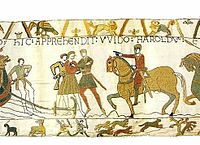
|
| 8 | ET DUXIT EUM AD BELREM ET IBI EUM TENUIT | and led him to Beaurain and held him there | 
|
| 9 | UBI HAROLD ET[note 5] WIDO PARABOLANT | Where Harold and Wido confer | 
|
| 10 | UBI NUNTII WILLELMI DUCIS VENERUNT AD WIDONE[M] | Where the messengers of Duke William came to Wido | 
|
| TUROLD | Turold[note 6] | 
| |
| 11 | NUNTII WILLELMI | The messengers of William | 
|
| 12 | HIC VENIT NUNTIUS AD WILGELMUM DUCEM | Here the messenger comes to Duke William | 
|
| 13 | HIC WIDO ADDUXIT HAROLDUM AD WILGELMUM NORMANNORUM DUCEM | Here Wido led Harold to William Duke of the Normans | 
|
| 14 | HIC DUX WILGELM[note 7] CUM HAROLDO VENIT AD PALATIU[M] SUU[M] | Here Duke William comes with Harold to his palace | 
|
| 15 | UBI UNUS CLERICUS ET AELFGYVA | Where a cleric and Ælfgyva...[note 8] |  Higher resolution detail |
| 16 | HIC WILLEM[US] DUX ET EXERCITUS EIUS VENERUNT AD MONTE[M] MICHAELIS | Here Duke William and his army came to the Mount of Michael | 
|
| 17 | ET HIC TRANSIERUNT FLUMEN COSNONIS | and here they crossed the Couesnon River |  Higher resolution detail |
| HIC HAROLD DUX TRAHEBAT EOS DE ARENA | Here Duke Harold dragged them from the sand | ||
| 18 | ET VENERUNT AD DOL ET CONAN FUGA VERTIT | and they came to Dol and Conan turned in flight |  Higher resolution detail |
| REDNES | Rennes | 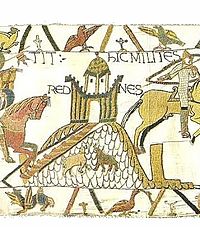
| |
| 19 | HIC MILITES WILLELMI DUCIS PUGNANT CONTRA DINANTES | Here the knights of Duke William fight against the men of Dinan | 
|
| 20 | ET CUNAN CLAVES PORREXIT | and Conan passed out the keys | 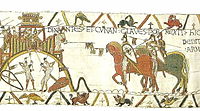
|
| 21 | HIC WILLELM[US] DEDIT ARMA HAROLDO | Here William gave arms to Harold | 
|
| 22 | HIC[note 9] WILLELM[US] VENIT BAGIAS | Here William came to Bayeux | 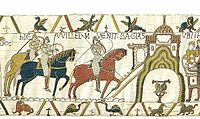
|
| 23 | UBI HAROLD SACRAMENTUM FECIT WILLELMO DUCI | Where Harold made an oath to Duke William | 
|
| 24 | HIC HAROLD DUX REVERSUS EST AD ANGLICAM TERRAM | Here Duke Harold returned to English land | 
|
| 25 | ET VENIT AD EDWARDU[M] REGEM | and he came to King Edward | 
|
| 26 | HIC PORTATUR CORPUS EADWARDI REGIS AD ECCLESIAM S[AN]C[T]I PETRI AP[OSTO]LI | Here the body of King Edward is carried to the Church of Saint Peter the Apostle[note 10] | 
|
| 27 | HIC EADWARDUS REX IN LECTO ALLOQUIT[UR] FIDELES | Here King Edward in bed speaks to his faithful followers |  Higher resolution detail |
| 28 | ET HIC DEFUNCTUS EST | and here he died[6] | |
| 29 | HIC DEDERUNT HAROLDO CORONA[M] REGIS | Here they gave the king's crown to Harold | 
|
| 30 | HIC RESIDET HAROLD REX ANGLORUM | Here sits Harold King of the English |  Higher resolution detail |
| 31 | STIGANT ARCHIEP[ISCOPU]S | Archbishop Stigand | |
| 32 | ISTI MIRANT[UR] STELLA[M] | These people marvel at the star [note 11] | 
|
| 33 | HAROLD | Harold | 
|
| 34 | HIC NAVIS ANGLICA VENIT IN TERRAM WILLELMI DUCIS | Here an English ship came to the land of Duke William | 
|
| 35 | HIC WILLELM[US] DUX JUSSIT NAVES [A]EDIFICARE | Here Duke William ordered ships to be built | 
|
| 36 | HIC TRAHUNT NAVES AD MARE | Here they drag the ships to the sea | 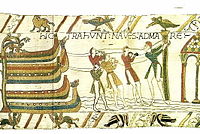
|
| 37 | ISTI PORTANT ARMAS AD NAVES ET HIC TRAHUNT CARRUM CUM VINO ET ARMIS | These men carry arms to the ships and here they drag a cart (laden) with wine and arms | 
|
| 38 | HIC WILLELM[US] DUX IN MAGNO NAVIGIO MARE TRANSIVIT ET VENIT AD PEVENESAE | Here Duke William in a great ship crossed the sea and came to Pevensey | |
| 39 | HIC EXEUNT CABALLI DE NAVIBUS | Here the horses leave the ships | 
|
| 40 | ET HIC MILITES FESTINAVERUNT HESTINGA UT CIBUM RAPERENTUR | and here the knights have hurried to Hastings to seize food |  Higher resolution detail |
| 41 | HIC EST WADARD | Here is Wadard[note 6] | 
|
| 42 | HIC COQUITUR CARO ET HIC MINISTRAVERUNT MINISTRI | Here the meat is being cooked and here the servants have served (it) | 
|
| 43 | HIC FECERUN[T] PRANDIUM | Here they made breakfast[7] | 
|
| HIC EPISCOPUS CIBU[M] ET POTU[M] BENEDICIT | And here the bishop blesses the food and drink |  Higher resolution detail | |
| 44 | ODO EP[ISCOPU]S WILLEM[US] ROTBERT | Bishop Odo, William, Robert | 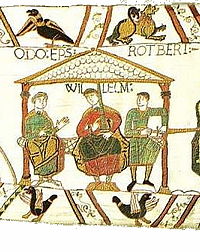
|
| 45 | ISTE JUSSIT UT FODERETUR CASTELLUM AT HESTENGA [note 12] | He ordered that a motte should be dug at Hastings |  Higher resolution detail |
| CEASTRA [note 12] | the camp | ||
| 46 | HIC NUNTIATUM EST WILLELM[O] DE HAROLD[O] | Here it was announced to William concerning (the approach of?) Harold | 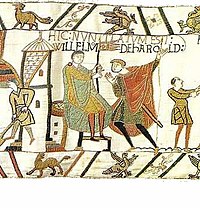
|
| 47 | HIC DOMUS INCENDITUR | Here a house is burned | 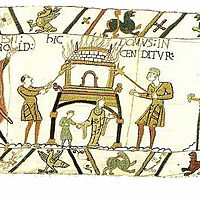
|
| 48 | HIC MILITES EXIERUNT DE HESTENGA ET VENERUNT AD PR[O]ELIUM CONTRA HAROLDUM REGE[M] | Here the knights have left Hastings and have come to the battle against King Harold | Higher resolution detail |
| 49 | HIC WILLELM[US] DUX INTERROGAT VITAL[EM] SI VIDISSET HAROLDI EXERCITU[M] | Here Duke William asks Vitalis[note 6] if he has seen Harold's army | 
|
| 50 | ISTE NUNTIAT HAROLDUM REGE[M] DE EXERCITU WILLELMI DUCIS | This man tells King Harold about Duke William's army | 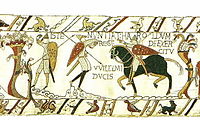
|
| 51 | HIC WILLELM[US] DUX ALLOQUITUR SUIS MILITIBUS UT PREPAREN[T] SE VIRILITER ET SAPIENTER AD PR[O]ELIUM CONTRA ANGLORUM EXERCITU[M] | Here Duke William speaks to[8] his knights to prepare themselves manfully and wisely for the battle against the army of the English |  
|
| 52 | HIC CECIDERUNT LEWINE ET GYRD FRATRES HAROLDI REGIS | Here have fallen dead[9] Leofwine and Gyrth, brothers of King Harold |  
|
| 53 | HIC CECIDERUNT SIMUL ANGLI ET FRANCI IN PR[O]ELIO | Here English and French fell at the same time in battle |  Higher resolution detail |
| 54 | HIC ODO EP[ISCOPU]S BACULU[M] TENENS CONFORTAT PUEROS | Here Bishop Odo, holding a club, gives strength to the boys | 
|
| 55 | HIC EST WILLEL[MUS] DUX | Here is Duke William | 
|
| 56 | E[USTA]TIUS | Eustace |  Higher resolution detail |
| HIC FRANCI PUGNANT ET CECIDERUNT QUI ERANT CUM HAROLDO | Here the French are fighting and have killed those who were with Harold | ||
| 57 | HIC HAROLD REX INTERFECTUS EST | Here King Harold is slain |  Higher resolution detail |
| 58 | ET FUGA VERTERUNT ANGLI[note 13] | and the English have turned in flight[note 13] |  Higher resolution detail |
Notes
- ^ William's uncle The Archbishop of Rouen spoke of wiping out the vainglorious French, "Francos debellare superbos"
- ^ Letters in square brackets are omitted on the tapestry either by way of abbreviation or where they are implied by a macron diacritic on the previous letter
- ^ Word was missing in 18th century copies
- ^ Wido is Guido or Guy, count of Ponthieu
- ^ ET is abbreviated as the Tironian note ⁊ (a character like a right-angled 7)
- ^ a b c Possibly vassal of Bishop Odo
- ^ Norman dialect form of "William"
- ^ A verb is missing, which makes this image the greatest mystery in the Tapestry. A notorious sexual assault on this English lady seems to have occurred, which was worthy of record. The attitude of the cleric is similar to that of the semi-obscene nude man in the lower margin. (Douglas, 1959, p.234)
- ^ The word has actually been embroidered "hIE". This is a typo.
- ^ Westminster Abbey
- ^ Halley's comet
- ^ a b The spelling of the Latin words ad and castra here have been cited by some in favour of the theory that the Tapestry was made in England (Douglas, D.C., 1959, p.237)
- ^ a b Caption was missing in 18th century copies
Sources
- Douglas, D.C., English Historical Documents 1042-1189, London, 1959, Bayeux Tapestry, pp. 232–278
References
- ^ Sir Frank Stenton (ed) et al, The Bayeux Tapestry. A comprehensive survey London: Phaidon, 1957 revised 1965.
- ^ a b c d e f Musset, Lucien (2005). The Bayeux Tapestry. Boydell Press. ISBN 1-84383-163-5. in its English edition (2005)
- ^ Panorama in Bibliotheca Augustana (Bibliotheca Augustana is a collection of electronic texts in Latin, Ancient Greek, English, French, German and Italian, ranging in date from classical times to the modern day. Hosted by: University of Applied Sciences, Augsburg)
- ^ based mainly on Stenton, Frank (1965). The Bayeux Tapestry. Phaedon Press. but also using Hicks, Carola (2006). The Bayeux Tapestry. The Life Story of a Masterpiece. Chatto and Windus. ISBN 0-7011-7463-3. and Musset, Lucien (2005). The Bayeux Tapestry. Boydell Press. ISBN 1-84383-163-5. in its English edition (2005)
- ^ Integral scene per Douglas, p.233
- ^ Cassell's Latin Dictionary: defungor, -functus sum deponent verb. Defunctus est, perfect tense
- ^ Cassell's Latin Dictionary, Ed. Marchant & Charles: Prandium, a late breakfast or lunch, taken about noon
- ^ or "harangues"
- ^ Cassell's Latin Dictionary: cado, cecidi, casum: to fall, die




